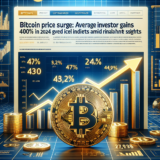Institutional Investors Boost Digital Asset Allocations to 7% by 2027: Key Insights from The Economist Report
In a groundbreaking report commissioned by crypto exchange OKX and published by The Economist, it has been revealed that institutional investors are projected to increase their digital asset allocations to an impressive 7% by 2027. This shift reflects a significant growth trajectory in the cryptocurrency sector, with the market for tokenized assets expected to surpass $10 trillion by 2030. However, while optimism surrounds this growth, there are notable challenges on the horizon.
Current State of Institutional Investment in Digital Assets
As of now, asset managers allocate between 1% and 5% of their assets under management (AUM) to digital assets. The report highlights that the focus of these investments has predominantly been on cryptocurrencies, with Bitcoin and Ethereum leading the way as the largest investment avenues. Yet, a surge in optimism is evident among institutional investors, driven by the expanding availability of various investment vehicles that extend beyond mere cryptocurrency holdings.
Diverse Investment Opportunities in Digital Assets
According to the report, a notable 51% of institutional investors are contemplating spot crypto allocations, while 33% are exploring staking digital assets. Additionally, 32% are looking at crypto derivatives, and 36% are considering funds that track cryptocurrencies. This diversification indicates a growing recognition of the potential of digital assets beyond traditional trading methods.
Innovative Digital Asset Solutions
Recent developments have also introduced innovative digital assets into the market, such as the European Investment Bank’s £50 million ($66 million) digitally native bond, along with $1 billion in tokenized U.S. Treasuries and HK$6 billion ($766.8 million) worth of Hong Kong digital currency bonds. These new investment instruments demonstrate that institutional investors are increasingly willing to look beyond just holding cryptocurrencies and are exploring various avenues for digital assets, including staking, crypto derivatives, and tokenized bonds.
The Role of Custodians in Institutional Crypto Adoption
Custodians are playing an essential role in facilitating the adoption of digital assets among institutional investors. The report indicates that 80% of traditional and crypto hedge funds surveyed are utilizing custodians. In Asia, several crypto custodians are obtaining the same licenses as their traditional finance counterparts. For instance, Hong Kong’s Trust or Company Service Provider (TCSP) is one such example, while Singapore’s Monetary Authority has established a dedicated framework for crypto custodians.
Challenges Facing Institutional Investors
Despite the promising growth and interest in digital assets, significant challenges loom over the landscape. One of the most pressing issues is the lack of regulatory harmony across different jurisdictions. The report highlights that this inconsistency creates uncertainty, making compliance navigation and risk management increasingly complicated for institutional investors.
The authors of the report commend Europe’s Markets in Crypto-Assets (MiCA) framework as a successful example of regional regulation that works. They warn, however, that varying approaches between regions can lead to market instability and complicate efforts for institutions to integrate digital assets into their portfolios effectively.
Liquidity Fragmentation: A Major Concern for Investors
Liquidity fragmentation poses another significant challenge for institutional investors. The report states that this fragmentation can lead to market instability and hinder efficient transaction execution in the digital asset space. Specifically, liquidity fragmentation across different blockchain networks and digital asset markets can result in price inefficiencies, presenting substantial challenges for institutions handling large-scale transactions.
Technological Solutions: Native Token Transfers
To address the issue of liquidity fragmentation, innovative technologies such as native token transfers are emerging as a promising solution. Native token transfers enable seamless cross-chain movement of tokens while preserving their unique properties and ownership. This stands in contrast to wrapped assets, which create multiple, non-fungible versions of tokens.
Comparative Insights from Recent Surveys
The findings from OKX’s report align closely with a recent survey conducted by Nomura, which revealed that 54% of Japanese institutional investors plan to invest in cryptocurrencies within the next three years. Moreover, 25% of respondents expressed a positive outlook on digital assets, with a preferred allocation of 2% to 5% of AUM. Such insights underscore the growing acceptance and integration of digital assets within institutional investment strategies.
Conclusion: The Future of Institutional Investment in Digital Assets
As institutional interest in digital assets continues to grow, the landscape is shifting rapidly. With the projected increase in allocations to 7% by 2027 and the anticipated market expansion for tokenized assets, it is clear that digital assets are becoming an integral part of institutional investment portfolios. However, to fully harness the potential of this growth, addressing regulatory challenges, liquidity fragmentation, and embracing innovative technologies will be paramount.
In summary, the report from The Economist not only highlights the increasing enthusiasm of institutional investors towards digital assets but also sheds light on the significant obstacles that lie ahead. As the market evolves, staying informed about the latest developments in cryptocurrency and blockchain technology will be essential for both investors and institutions alike.
For those interested in entering the digital asset space, resources such as How to Buy Bitcoin, How to Buy Ethereum, and How to Buy Solana can provide valuable guidance. Additionally, for insights on exchanges, check out our Kraken Review and Binance Review.











